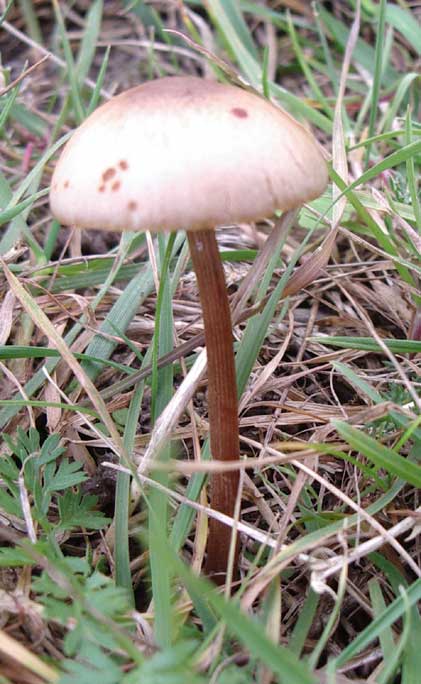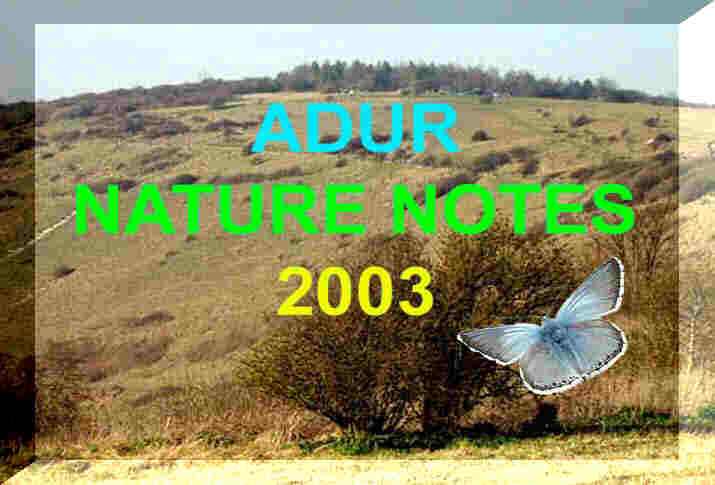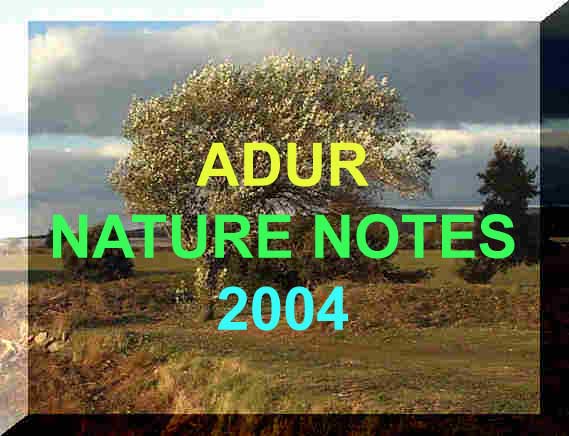


 |
 |
 |
This
mushroom
was seen amongst the Horseshoe Vetch
and probably the same species next to a Rabbit latrine (photograph
on the far right above) on the lower
slopes of Mill Hill.
The
cap diameter of his mushroom was estimated at 45 mm. The central photograph
was the orange-gilled mushroom on the right, but this mushroom was not
found growing but discarded, so its appearance may be more like a dried
mushroom than a fresh growing fungus.
Could
the species on the far right be Entoloma
sericeum?
 |
 |
 |
There
were Jew's Ears on a Hawthorn on the scrub on the lower ridge of
Mill
Hill. And I spotted what were half a dozen probable Bearded
Milkcap, Lactarius
pubescens, (a type of Milk-Cap)*
on the verges of Mill Hill Road where the Bee
Orchids were discovered earlier this year.
They were on grass and herbland about one metre from two Silver
Birch trees. This
fungus has an ectomycorrhizal
symbiosis with Birch.
(I identified these as Sulphur Tufts
before doubts crept in.)
NB:
I should have cut the gills of mushroom to see if it exuded milky fluid
('latex'); something to remember next time.
 |
23
October 2006
After the rain, a couple of mushrooms and the Nostoc commune (an algae) was there as expected on the lower slopes of Mill Hill. Again the mushrooms were difficult to identify. The gills were a greyish-white but similar mushrooms have been seen with black gills on the upper part of Mill Hill before. There was no sign of a ring around the stem. The cap was about the size of a commercial mushroom, an estimated 55 mm in diameter. Big
Blue Pinkgill
|
12
October 2006
 |
 |
On
the lower slopes of Mill
Hill, One medium-to-large white mushroom seen at the southern end had
a pure white cap with a diameter of 55 mm, white gills and a white 90 mm
stem with a ring, and it was probably the White
Dapperling, Leucoagaricus
leucothites. Two more were seen in
the central area of Mill Hill.
Adur
Fungi 2006
 |
 |
On
the lower slopes of Mill Hill, a handful
of small mushrooms (illustrated above) protruded above the short
grass and herbs. This fungus has yet to be identified as there are too
many similar mushrooms to be sure. There was another larger mushroom just
above the ridge (illustrated below), but this had black gills and appears
to be a different but not identified species. These were species seen frequently
before and every year at varying times, usually after rain. I have not
included the size of the fungus below. The estimated cap diameter is 40
mm.
More
Images from previous records
The best suggestion was the species Stropharia coronilla.
 |
 |
The mushrooms above are Agaricus, and probably not with a yellow base to the stalk when cut, thus probably not A. xanthodermus.
The
following mushrooms were growing on a Hawthorn
and these are Honey Fungus.
 |
 |
 |
 |
 |
 |
I think this is a different species: this is probably the Dung Fungus, Stropharia semiglobata.
 18
April 2005
18
April 2005
The
strange and unusual looking Morel
Mushroom,
Morchella esculenta,
was
seen on the side of the Pixie Path to
Mill
Hill. It looked dried out but I expect
they always look like this. There were small orange ants around the base
of the mushroom.
 |
 |
As this species was growing out of the soil it is thought to be Mycena flavescens. There is a similar species Mycena arcangeliana which grows on wood.
11
November 2004
In
the fading light of late afternoon, the bare upper slopes of short grass
south and south-west of the upper car park hosted a couple of dozen or
more of several varieties of mostly small mushrooms. All the small mushrooms
were found in an area of about three square metres. The was at least one
large mushroom which looked an old brown version of Leucoagaricus
leucothites.
 |
 |
 |
 |
| The identity of this small mushroom, (cap diameter 20 mm) is still a puzzle. It has been discovered before on the lower slopes of Mill Hill. In other specimens the spore print was dark brown. | There at least a dozen, probably more of these small (>30 mm cap diameter) mushrooms. ID is under enquiry. Click on all these images for a larger photograph. | There was only one seen of this similarly sized mushroom, and although the gills did not seem to be decurrent like the white mushroom, it could well be the same species. | This is the same species and same colour as the other white mushroom (larger at 50 mm cap diameter) and flash photograph has produced a colour hue. |
The white species (second left and far right) was also found next to the path in the Triangle area. The mushroom top of the shortlist is the Snowy Cap, Hygrocybe virginea var. virginea (= Cuphophyllus niveus) (or it could be the Pale Wax Cap, Hygrocybe pratensis var pallida).
This species has now been confirmed as the Pale Wax Cap, Hygrocybe berkeleyi, (known on the British Mycological List as Hygrocybe pratensis var pallida).
Cercle de Mycologie de mons (Belgique) page perso de JJ.WuilbautThere could also have been a solitary small brown Conocybe mushroom.
9 November
2004
 |
 |
The
two small mushrooms in the photographs above only reached 30 mm in cap
diameter and most of the small clump, on the footpath approach to Mill
Hill from the Waterworks Road, were about
20 mm. They have not been identified.
The
spore print of this mushroom turned out to be white.
With
the latest photographs this species has now been identified as probably
being a Dermoloma, if blackening, Dermoloma magicum.
This
latter species is a new one to the British
fungal list, not because it is rare though. This was difficult for
me to identify because all the pictures
available show Dermoloma with white or cream gills. All these specimens
had brown gills as shown in the photographs. The cap in the specimen above
is beginning to show white lines which were not present in the smaller
mushrooms. This seems to be a feature of this genus.
8
November 2004
The
particular mushroom which is regularly found on the lower
slopes of Mill Hill presents a bit of identification problem in its
deteriorated state, and it appears to look in a rather poor condition rather
rapidly.
 |
 |
 |
 |
It is debatable if it is a very old example of Leucoagaricus leucothites, without a stem ring and with the mushroom turning from white to brown in a week, or perhaps Lepista sordida, which deteriorates rapidly, or perhaps neither of these species? It is probably the first species which changes from white and appears browner as it ages.
There were at least two specimens of the large mushroom Volvariella gloiocephala (illustrated below) on the road verge. The largest specimen had a flat cap and measured 93 mm in diameter. The smaller more elegant mushroom had a conical cap and this appeared smaller, although the actual mushroom was as tall as the wider specimen.
Whereas
after the dry summer of 2003, Mill Hill
was parched and the grass and herblands were almost devoid of fungi,
this year, there seems to be dozens of what are almost certainly common
species scattered thinly over the whole area. All
the images can be enlarged by left clicking on them.
 |
 |
The
disintegrating fungi south of reservoir come be one of several species.
This is a potentially large species with one cap diameter estimated at
95 mm. The gills are much paler and the inset part of the photograph shows
the gills to have a grey-lilac tinge. The smaller
firmer brown-gilled mushroom (right) is
probably another species. This one has been seen frequently on Mill Hill
but it has not yet been named.
 |
  |
 |
 |
 |
The tall species (illustrated above left) is the first species I have discovered with a volva in the ground. This was left behind on the roadside verge south of the reservoir (country road to from Mill Hill to Beeding Hill) when the stem was pulled off for a closer look. The 60 mm (measured underneath because of the convex cap) diameter cap was slightly greenish and the gills were fawn coloured. There was no sign of a stem ring. The stem was 100 mm high. There was no smell to this mushroom. The light played tricks making the fungus look much paler at times. With my shadow over the mushroom, the gills and cap appeared much darker. This species is Volvariella gloiocephala. It has a recommended name of Stubby Rosegill. It seems to be a species quite often discovered.
PS: I have this species being discovered before and known as the Straw Mushroom, Volvariella speciosa. Volva:
A "volva" is a ruptured, sack-like covering at the base of the mushroom's
stem. The volva results from the mushroom pushing through the universal
veil, which covers young buttons to protect them. Many species of Amanita,
including some of the deadliest mushrooms on earth, have volvas, as do
Volvariella
and some other fungi.
Volva:
A "volva" is a ruptured, sack-like covering at the base of the mushroom's
stem. The volva results from the mushroom pushing through the universal
veil, which covers young buttons to protect them. Many species of Amanita,
including some of the deadliest mushrooms on earth, have volvas, as do
Volvariella
and some other fungi.
Because
the deadly Amanita mushrooms
have volvas, it is essential for novices to learn how to recognize this
feature. Sometimes volvas are buried, and they are not always as prominent
as they are in a typical Amanita phalloides
or Volvariella gloiocephala
--
so you should be sure to dig out the base of the mushroom in question and
inspect it carefully!
Mycologist's
Glossary
The
similar
Death Cap,
Amanita
phalloides, has been mistaken for this mushroom with fatal results.
  |
There
were what was could be (although lacking the stem ring) poor condition
old specimens (left) of Leucoagaricus
leucothites in the pasture to the east with the smaller familiar-looking
small
brown mushroom with a thin brown stem
(image on the right, above). The brown mushroom may be a species of Conocybe?
Both these mushrooms were on the pasture to the east of Mill Hill.
 |
The
first (above left) of more than a dozen small
brown mushrooms with a pale brown stem
were discovered on the edge of footpath approach to Mill Hill from the
Waterworks
Road, and the second (right), which seems
to be a different species with a white
creamy stem was a solitary mushroom in
amongst the herbs on the
lower slopes of Mill
Hill. Neither species has been identified. The cap diameters of these mushrooms
were from 15 mm to 20 mm. Later, a white spore
print was obtained from the mushrooms on the left immediately above. A
similar mushroom (on the right) from the same location produced a dark
brown spore print.
 |
The Golden Wax Caps, Hygrocybe chlorophana, on the A27 road bank had deteriorated (above left) and the larger white-fawn mushroom with pale gills was found on the edge of the ridge on Mill Hill. The cap diameter of this species was about 60 mm with a shortish stalk and brown gills. I am not sure of the identity of this species but I think this is a large Coprinus, an Ink Cap, but I do not know which species. The cap looks like a Lepiota but the gills are more brownish.
Without
looking for mushrooms, I could not help but almost falling over them. Identification
is very tricky.
 |
 |
This
mushroom is the Golden Wax Cap,
Hygrocybe
chlorophana. They were discovered on the
A27 road embankment just east of the bridge section where it crosses the
Waterworks
Road. The Dune Wax Cap, Hygrocybe
conicoides, was discovered nearby as well as the poisonous
mushroom Clitocybe possibly dealbata.
Fungi
of Shoreham
Adur
Hygrocybe
(Wax
Caps)
Adur
Fungi: Fruiting Bodies (Monthly Guide)
 |
 |
The Wax Caps of yesterday (now: above, centre and right) had now grown and were large enough to try and identify them. The scarlet caps were at least 32 mm in diameter. The fungi are on the path and they are not expected to last. There are 63 species of Hygrocybe found in Britain. They have been identified as the Dune Wax Cap, Hygrocybe conicoides.
Sometimes this species is recorded as Hygrocybe conica var conicoides.25
October 2004
The
was a small mushroom (first
picture on the left, above) on
the the muddy footpath approach to
Mill
Hill from the Waterworks
Road, with a conical cap 10 mm in diameter
when measured from the side. I have postponed trying to put an instant
name to this small mushroom, photographed immediately on the right. This
is likely to be a species of wax cap, Hygrocybe,
Hygrocybe
conica or Hygrocybe
coccinea.
The
spore print of this mushroom was white but this does not give an indication
to species as the first few Hygrocybe looked at in the book all
had white spore prints. This all seem strange to get a white spore print
from a brown mushroom.
2 August
2004
Another
photograph was possible of the mushroom
in the copse at the top of Mill
Hill, which looked edible when it was fresh:
 |
 |
Fungi
Images on the Web (Index)
Mycologist's
Glossary
 20
April 2004
20
April 2004
A
solitary mushroom was amongst the still short grass near a Hawthorn bush.
I recognised it immediately as a Morel,
Morchella
esculenta, because of its unusual distinctive
appearance. I had not seen one before and although an edible species, I
left it in its place just south of the car park.
Adur
Fungi: Fruiting Times
Fungi
of Shoreham

